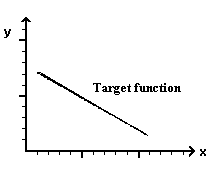sitemap
a – z

|
|
Home Maria Oelinger sitemap a – z |

|
List of Contents 1.2 1.3 Kacprzyk, Orlovski Lai, Hwang Notations + Definitions
We look at optimazation models of the form
z(x) = x = c1x1 + … + cnxn —> Max
in compliance with the fuzzy restrictions
Ai1x1 ![]() …
… ![]() Ainxn
Ainxn ![]() Bi
i = 1, …, m
Bi
i = 1, …, m
and
x1, …, xn ![]() 0.
0.
To simplify matters it should be considered
for all coefficients
Aij and the right sides Bi in the following, that the
reference functions are
L(u) = R(u) = Max {0, 1 – u}
.
In general you can use all kinds of reference functions, of course.
|
Aij = (aij; oij; |
are fuzzy intervals and |
|
Bi = (bi; 0; |
are
fuzzy numbers on the
|
Target function should be
z (x, y) = 4x + 7y —> Max

under the subconditions
x, y ![]() 0
0
(A) (2; 2; 0.5; 0.5) 0.1 x ![]() (1.5; 2; 0.5; 1) 0.1 y
(1.5; 2; 0.5; 1) 0.1 y ![]() (20; 0; 8) 0.1
(20; 0; 8) 0.1

(B) (3; 4; 1; 1.5) 0.1 x ![]() (5; 6; 1; 1) 0.1 y
(5; 6; 1; 1) 0.1 y ![]() (48; 0; 12) 0.1
(48; 0; 12) 0.1

(C)
![]() (2.5; 3; 0.5; 0.4) 0.1 y
(2.5; 3; 0.5; 0.4) 0.1 y ![]() (18; 0; 7) 0.1
(18; 0; 7) 0.1

List of Contents 1.2 1.3 Kacprzyk, Orlovski Lai, Hwang Notations + Definitions
Feel free to send me email: maria@oelinger.de
|
© 1999-2001 Maria Oelinger cand. math. |
Seminar Fuzzymathematik 1998 |
Letzte Änderung: 25.04.2001 address: http://www.oelinger.de/maria/en/fuzzy/rommelfanger_intro.htm |